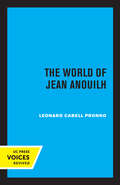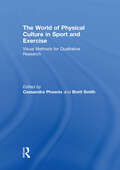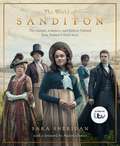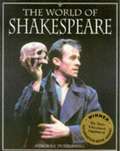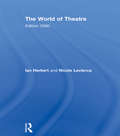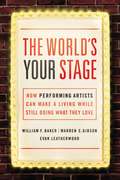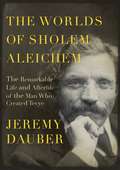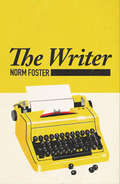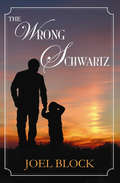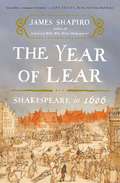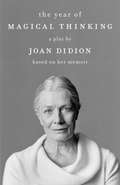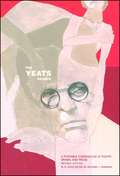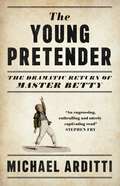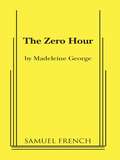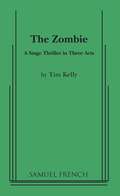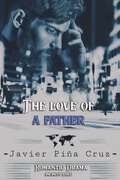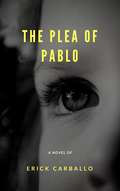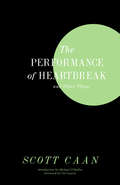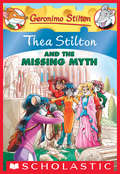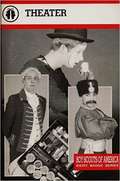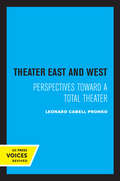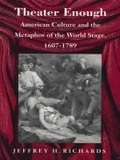- Table View
- List View
The World of Jean Anouilh
by Leonard C. PronkoThis title is part of UC Press's Voices Revived program, which commemorates University of California Press’s mission to seek out and cultivate the brightest minds and give them voice, reach, and impact. Drawing on a backlist dating to 1893, Voices Revived makes high-quality, peer-reviewed scholarship accessible once again using print-on-demand technology. This title was originally published in 1961.
The World of Physical Culture in Sport and Exercise: Visual Methods for Qualitative Research
by Cassandra Phoenix and Brett SmithWithin qualitative research in the social sciences, the last decade has witnessed a growing interest in the use of visual methods. Visual Methods in Physical Culture is the first book in the field of sport and exercise sciences dedicated to harnessing the potential of using visual methods within qualitative research. Theoretically insightful, and methodologically innovative, this book represents a landmark addition to the field of studies in sport, exercise, the body, and qualitative methods. It covers a wide range of empirical work, theories, and visual image-based research, including photography, drawing, and video. In so doing, the book deepens our understanding of physical culture. It also responds to key questions, such as what are visual methods, why might they be used, and how might they be applied in the field of sport and exercise sciences.This volume combines clarity of expression with careful scholarship and originality, making it especially appealing to students and scholars within a variety of fields, including sport sociology, sport and exercise psychology, sociology of the body, physical education, gender studies, gerontology, and qualitative inquiry. This book was published as a special issue in Qualitative Research in Sport and Exercise.
The World of Sanditon: The Official Companion to the ITV Series
by Sara SheridanThe official TV tie-in to accompany the ITV drama scripted by Andrew DaviesThe World of Sanditon delves behind the scenes of Sanditon, giving you the inside scoop on Jane Austen's unfinished masterpiece, adapted for television by Andrew Davies.Produced by Red Planet Pictures, ITV's Sanditon series tells the story of the joyously impulsive, spirited and unconventional Charlotte Heywood and her spiky relationship with the humorous, charming and slightly wild Sidney Parker. Written by Emmy and BAFTA-Award winning writer Andrew Davies, the series brought Austen's story to life and this book will allow you to go behind the scenes of the cast and crew, exploring the world that Austen created and offering fascinating insights about the period and about the real-life heartbreak behind her final story. Readers will also have access to location guides, interviews with the cast, and in-depth historical information by esteemed author Sara Sheridan.
The World of Shakespeare
by Anna Claybourne Rebecca TreaysThis is an introduction to the life and work of William Shakespeare. The book covers every aspect of the genius of Shakespeare, revealing the world he lived in, examining his controversial life, exploring his rich and varied works, and meeting his fascinating characters. A description is given of how Shakespeare's plays were performed when he was alive, and a look behind the scenes is given as a modern drama company prepares to stage a new production. A reference section contains plot summaries, glossaries and a Shakespeare quiz.
The World of Tacitus' Dialogus de Oratoribus
by Christopher S. van den BergComing to terms with the rhetorical arts of antiquity necessarily illuminates our own ideas of public discourse and the habits of speech to which they have led. Tacitus wrote the Dialogus at a time (ca. 100 CE) when intense scrutiny of the history, the definitions, and the immediate relevance of public speech were all being challenged and refashioned by a host of vibrant intellects and ambitious practitioners. This book challenges the notion that Tacitus sought to explain the decline of oratory under the Principate. Rather, from examination of the dynamics of argument in the dialogue and the underlying literary traditions there emerges a sophisticated consideration of eloquentia in the Roman Empire. Tacitus emulates Cicero's legacy and challenges his position at the top of Rome's oratorical canon. He further shows that eloquentia is a means by which to compete with the power of the Principate.
The World of Theatre: Edition 2000
by Ian Herbert Nicole LeclercqThe World of Theatre is an on-the-spot account of current theatre activity across six continents. The year 2000 edition covers the three seasons from 1996-97 to 1998-99, in over sixty countries - more than ever before. The content of the book is as varied as the theatre scene it describes, from magisterial round-ups by leading critics in Europe (Peter Hepple of The Stage) and North America (Jim O'Quinn of American Theatre) to what are sometimes literally war-torn countries such as Iran or Sierra Leone.
The World's Your Stage: How Performing Artists Can Make a Living While Still Doing What They Love
by William F. Baker Warren C. Gibson Evan LeatherwoodIf you're like most performing artists, you're not in it for the money. Whether you're a musician, a dancer, or an actor, you've spent years mastering your craft. But to make it your career--you need to figure out how to get paid. Jobs are scarce and talent alone no longer assures success. Today's performers need to hone their entrepreneurial skills and create their own careers. Inspired by the celebrated Juilliard course, The World's Your Stage explains the business side of the performing arts. Filled with insights from leading figures in the arts as well as lessons from thriving artist-entrepreneurs, the book helps you: Understand the numbers Find your niche--and fill it Market and promote yourself and your venture Network productively Fundraise both online and off Balance artistic and financial growth with the Oportunity Framework And more. Keep your dream alive, but keep a clear eye on the facts. With planning and work, you can make a living doing what you love--you just need to learn how.
The Worlds of Sholem Aleichem: The Remarkable Life and Afterlife of the Man Who Created Tevye (Jewish Encounters Series)
by Jeremy DauberPart of the Jewish Encounters seriesThe first comprehensive biography of one of the most beloved authors of all time: the creator of Tevye the Dairyman, the collection of stories that inspired Fiddler on the Roof. Novelist, playwright, journalist, essayist, and editor, Sholem Aleichem was one of the founding giants of modern Yiddish literature. The creator of a pantheon of characters who have been immortalized in books and plays, he provided readers throughout the world with a fascinating window into the world of Eastern European Jews as they began to confront the forces of cultural, political, and religious modernity that tore through the Russian Empire in the final decades of the nineteenth century. But just as compelling as the fictional lives of Tevye, Golde, Menakhem-Mendl, and Motl was Sholem Aleichem's own life story. Born Sholem Rabinovich in Ukraine in 1859, he endured an impoverished childhood, married into fabulous wealth, and then lost it all through bad luck and worse business sense. Turning to his pen to support himself, he switched from writing in Russian and Hebrew to Yiddish, in order to create a living body of literature for the Jewish masses. He enjoyed spectacular success as both a writer and a performer of his work throughout Europe and the United States, and his death in 1916 was front-page news around the world; a New York Times editorial mourned the loss of "the Jewish Mark Twain." But his greatest fame lay ahead of him, as the English-speaking world began to discover his work in translation and to introduce his characters to an audience that would extend beyond his wildest dreams. In Jeremy Dauber's magnificent biography, we encounter a Sholem Aleichem for the ages.(With 16 pages of black-and-white illustrations)
The Writer
by Norm FosterDonald Wellner knew success when he wrote a hit play thirty-five years ago, but now he’s recently separated, living in a small apartment, and promising that he’s trying to start a new script. His fortysomething son Blake is a travel writer with commitment issues who pops by between trips to try to hold his family together and prove his worth. Over seven years, Donald experiences the onset of dementia, and father and son become both closer and farther apart. This story of familial bonds provides delightfully comical and satisfyingly sentimental clarity in those small moments that will last forever.
The Wrong Schwartz
by Joel BlockIt might have been just another messy marital triangle with routine melodrama: the stale marriage, the affair--his and hers--and the recriminations. But volatile passions intersected in a manner not unlike the coupling of an explosive and a detonator. Mark Shapiro is a handsome, enormously successful cardiac surgeon with a loving wife, an adoring son, plenty of money and a nightmare in the making. As successful as he is, he hungers for more notoriety and is drawn into believing a mysterious and alluring woman he has met will bring it to him. He also hungers for her. It is an out-of-control type of appetite, nothing short of sexual obsession. All marriages have ups and downs, but when Mark learns who "Mr. Tuesday" is, his wife's lover, his rage is not diminished by his own affair. One night, still irresistibly drawn to the other woman--whose promise has turned to horror--he learns more than he ever wanted to know about the palpable dangers of ambition.
The Year of Lear: Shakespeare in 1606
by James ShapiroPreeminent Shakespeare scholar James Shapiro shows how the tumultuous events in England in 1606 affected Shakespeare and shaped the three great tragedies he wrote that year--King Lear, Macbeth, and Antony and Cleopatra.In the years leading up to 1606, since the death of Queen Elizabeth and the arrival in England of her successor, King James of Scotland, Shakespeare's great productivity had ebbed, and it may have seemed to some that his prolific genius was a thing of the past. But that year, at age forty-two, he found his footing again, finishing a play he had begun the previous autumn--King Lear--then writing two other great tragedies, Macbeth and Antony and Cleopatra. It was a memorable year in England as well--and a grim one, in the aftermath of a terrorist plot conceived by a small group of Catholic gentry that had been uncovered at the last hour. The foiled Gunpowder Plot would have blown up the king and royal family along with the nation's political and religious leadership. The aborted plot renewed anti-Catholic sentiment and laid bare divisions in the kingdom. It was against this background that Shakespeare finished Lear, a play about a divided kingdom, then wrote a tragedy that turned on the murder of a Scottish king, Macbeth. He ended this astonishing year with a third masterpiece no less steeped in current events and concerns: Antony and Cleopatra. The Year of Lear sheds light on these three great tragedies by placing them in the context of their times, while also allowing us greater insight into how Shakespeare was personally touched by such events as a terrible outbreak of plague and growing religious divisions. For anyone interested in Shakespeare, this is an indispensable book.
The Year of Magical Thinking: The Play
by Joan Didion"This happened on December 30, 2003. That may seem a while ago but it won't when it happens to you ..." In this dramatic adaptation of her award-winning, bestselling memoir (which Michiko Kakutani in The New York Times called "an indelible portrait of loss and grief ... a haunting portrait of a four-decade-long marriage".) Joan Didion transforms the story of the sudden and unexpected loss of her husband and their only daughter into a stunning and powerful one-woman play. The first theatrical production of The Year of Magical Thinking opened at the Booth Theatre on March 29, 2007, starring Vanessa Redgrave and directed by David Hare.
The Yeats Reader, Revised Edition: A Portable Compendium of Poetry, Drama, and Prose
by Richard J. Finneran William Butler YeatsThroughout his long life, William Butler Yeats -- Irish writer and premier lyric poet in English in this century -- produced important works in every literary genre, works of astonishing range, energy, erudition, beauty, and skill. His early poetry is memorable and moving. His poems and plays of middle age address the human condition with language that has entered our vocabulary for cataclysmic personal and world events. The writings of his final years offer wisdom, courage, humor, and sheer technical virtuosity. T. S. Eliot pronounced Yeats "the greatest poet of our time -- certainly the greatest in this language, and so far as I am able to judge, in any language" and "one of the few whose history is the history of their own time, who are a part of the consciousness of an age which cannot be understood without them."The Yeats Reader is the most comprehensive single volume to display the full range of Yeats's talents. It presents more than one hundred and fifty of his best-known poems -- more than any other compendium -- plus eight plays, a sampling of his prose tales, and excerpts from his published autobiographical and critical writings. In addition, an appendix offers six early texts of poems that Yeats later revised. Also included are selections from the memoirs left unpublished at his death and complete introductions written for a projected collection that never came to fruition. These are supplemented by unobtrusive annotation and a chronology of the life.Yeats was a protean writer and thinker, and few writers so thoroughly reward a reader's efforts to essay the whole of their canon. This volume is an excellent place to begin that enterprise, to renew an old acquaintance with one of world literature's great voices, or to continue a lifelong interest in the phenomenon of literary genius.
The Young Pretender
by Michael Arditti"An engrossing, enthralling and utterly captivating read, The Young Pretender tells a simply remarkable story with bounce, energy, wit, and lively authenticity . . . Michael Arditti's brilliant imaginative achievement offers high comedy, dark tragedy and everything between" STEPHEN FRY"The Young Pretender is an absolute joy - charming and funny, with the lightest hint of melancholy, and a wonderfully imaginative recreation of the Georgian theatre scene" KATE SAUNDERS"I loved how Arditti conjures...the smell of the theatre and the ghosts of these bygone players that haunt the stage...and the wonderful period details. Arditti wears his research so lightly" LARUSHKA IVAN-ZADEH, reviewing on Radio 4's FRONT ROW *****Mobbed by the masses, lionised by the aristocracy, courted by royalty and lusted after by patrons of both sexes, the child actor William Henry West Betty was one of the most famous people in Georgian Britain.At the age of thirteen, he played leading roles, including Romeo, Macbeth and Richard III, in theatres across the country. Prime Minister William Pitt adjourned the House of Commons so that its members could attend his debut as Hamlet at Covent Garden. Then, as rivals turned on him and scandal engulfed him, he suffered a fall as merciless as his rise had been meteoric."Arditti's voice as Betty is impeccable. He is touchy, sometimes myopic, sincere in his ambitions. His attempts to reclaim lost glory are run through with an affecting melancholy" The TimesThe Young Pretender takes place during Betty's attempted comeback at the age of twenty-one. As he seeks to relaunch his career, he is forced to confront the painful truths behind his boyhood triumphs. Michael Arditti's revelatory new novel puts this long forgotten figure back in the limelight. In addition to its rich and poignant portrait of Betty himself, it offers an engrossing insight into both the theatre and society of the age. The nature of celebrity, the power of publicity and the cult of youth are laid bare in a story that is more pertinent now than ever."Entrancing and disturbing" ALLAN MASSIE, The Scotsman"Michael Arditti tells a story of a Regency child star with great panache and compassion, bringing a forgotten celebrity back to life for the modern age. A compelling read I was sad to finish." LINDA GRANT"Michael Arditti is a writer who takes risks. His material is always compelling and provocative, his techniques sophisticated and oblique" PATRICIA DUNCKER, Independent on Sunday "Arditti is a master storyteller" PETER STANFORD, Observer
The Young Pretender
by Michael Arditti"An engrossing, enthralling and utterly captivating read, The Young Pretender tells a simply remarkable story with bounce, energy, wit, and lively authenticity . . . Michael Arditti's brilliant imaginative achievement offers high comedy, dark tragedy and everything between" STEPHEN FRY"The Young Pretender is an absolute joy - charming and funny, with the lightest hint of melancholy, and a wonderfully imaginative recreation of the Georgian theatre scene" KATE SAUNDERS"I loved how Arditti conjures...the smell of the theatre and the ghosts of these bygone players that haunt the stage...and the wonderful period details. Arditti wears his research so lightly" LARUSHKA IVAN-ZADEH, reviewing on Radio 4's FRONT ROW *****"A vivid, highly detailed portrait of life in rumbustious Regency London" Mail on SundayMobbed by the masses, lionised by the aristocracy, courted by royalty and lusted after by patrons of both sexes, the child actor William Henry West Betty was one of the most famous people in Georgian Britain.At the age of thirteen, he played leading roles, including Romeo, Macbeth and Richard III, in theatres across the country. Prime Minister William Pitt adjourned the House of Commons so that its members could attend his debut as Hamlet at Covent Garden. Then, as rivals turned on him and scandal engulfed him, he suffered a fall as merciless as his rise had been meteoric."Arditti's voice as Betty is impeccable. He is touchy, sometimes myopic, sincere in his ambitions. His attempts to reclaim lost glory are run through with an affecting melancholy" The TimesThe Young Pretender takes place during Betty's attempted comeback at the age of twenty-one. As he seeks to relaunch his career, he is forced to confront the painful truths behind his boyhood triumphs. Michael Arditti's revelatory new novel puts this long forgotten figure back in the limelight. In addition to its rich and poignant portrait of Betty himself, it offers an engrossing insight into both the theatre and society of the age. The nature of celebrity, the power of publicity and the cult of youth are laid bare in a story that is more pertinent now than ever."Entrancing and disturbing" ALLAN MASSIE, The Scotsman"Michael Arditti tells a story of a Regency child star with great panache and compassion, bringing a forgotten celebrity back to life for the modern age. A compelling read I was sad to finish." LINDA GRANT"Michael Arditti is a writer who takes risks. His material is always compelling and provocative, his techniques sophisticated and oblique" PATRICIA DUNCKER, Independent on Sunday "Arditti is a master storyteller" PETER STANFORD, Observer
The Zero Hour
by Madeleine GeorgeCharacters: 1 male, 2 femaleUnit SetRebecca and her chronically unemployed butch girlfriend, O, have created a happy nest in their run-down walk-up in Queens, but things are starting to unravel. The more O pushes Rebecca to stop hiding their relationship, the more Rebecca's work life-writing a textbook for seventh graders about the Holocaust- begins to bleed into her personal life: She starts meeting World War II Nazis on the 7 train, passing as hipster professionals in New York City but hungry to come out about who they really are. Back home in Queens, O is also sparring with convincingly real visions: her long estranged-and recently dead?-mother keeps showing up to argue with her about her choices. This almost-love story explores the relationship between honesty and cruelty: How do you tell the truth about yourself when that truth might devastate the people you love? A tour-de-force for two actors playing eight different roles."A lucid drama. Appealingly brainy and messy, George's play never settles for an easy metaphor or emotion. It cross-examines our pat notions of history and love."- The New Yorker"Grabs our interest from its first provocative line. The Zero Hour is a work to savor."- Back Stage"Bold, thoughtful, and incredibly beautiful." - CurtainUp"A striking new play. Refreshingly original." -TheatreMania
The Zombie
by Tim KellyThis is a comedy thriller in a weird and sinister setting the Okefenokee Swamp in Florida where voodoo practices are accepted. In a decayed mansion dripping with cobwebs and mystery, a former carnival hypnotist calling himself Baron Samedi and a crooked sheriff have developed an "unusual" business. They turn illegal immigrants, petty criminals and intruders into zombies and lease them out as farm laborers. Profits and success aren't enough, however. The hypnotist wants revenge against those who have wronged him in the past. Soon the house is shaking with thrills, shivering shocks, and a startling climax. For the young television producer and his two girls friends who stumble onto the grim proceedings, it's a night to remember, especially when they encounter "The Walking Dead". Despite the goosebumps, this chiller is loaded with genuine comedy and keeps its audience in a state of taut excitement and laughter. The roles are fun and production needs are simple.
The love of a father (Infinite Love #1)
by Javier Piña CruzLove is a simile of pain… Every now and then, love shatters uswithin our heart, in pieces of apuzzle we are incapable of fitting again until that long lost piece missing, appears, enters your life and, without knowing how, you are fulfilled again. I am called Daniel and I learnt the feeling when your heart is crushed and at the same time, the happiness thanks to Náyade, my child and world. Due to this, time was the only witness of my scars, and when I thought I was going down again, love held me to teach me, once again, to be strong. My history is part of life, and life is no hallway of roses. There was a time that, for me, all was a chaos of events which almost cracked me, cause hell broke lose and wanted to tear apart me from what the love of a father means.
The plea of Pablo
by Erick Carballo"The plea of Pablo" is a novel in which the loneliness, bullying, vice and selfishness of a father are intertwined, and the indifference of a mother who abandons her son to his fate to start a new life with a man who assures you a promising future. Pablo is an eight-year-old boy who has only one friend he can trust, but a series of events lead him to a tragic destiny.
The trace of the fire
by Claudio CalzoniThe trace of the fire by Claudio Calzoni The trace of the fire: from Notre Dame to the Mole Antonelliana. The trace of the fire There is a trace of the fire behind the death of so many people, the destruction of monuments that guard the memory of Humanity and a relic, the most important that Christianity has preserved for millennia. The chess game between Good and Evil has begun. The players move their pieces. Whoever puts the King in check will win. It is not easy to find but the trace of Fire is in the air...
ThePerformanceofHeartbreak
by Scott Caan Val Lauren Robert CarnegieA collection of eleven one-act plays. With hints of Samuel Beckett, Sam Shepard, Neil LaBute, and Tracy Letts, Scott Caan grapples with the emotional interiors of people in a fractured world. Whether writing about actors, lovers, or co-workers, Caan takes on the complicated tension between what we say and what we feel, how we grapple with the world publicly and privately, and what that difference says about us as people. Caan's training as an actor imbues his words with a sense of play and the characters he leaves other actors to create within these plays are deep and open to interpretation. The Performance of Heartbreak and Other Plays is the introduction of an exciting new voice in American theater.
Thea Stilton and the Missing Myth: A Geronimo Stilton Adventure (Thea Stilton Graphic Novels #20)
by Thea StiltonJoin Thea Stilton and the Thea Sisters on an adventure packed with mystery and friendship! <p><p> While on vacation in Greece, the Thea Sisters make friends with a company of actors who are rehearsing for a play that's about to open. When an actress sprains her ankle, Colette ends up standing in for her! But suddenly, right before the performance, the lead actor goes missing. Can the mouselets find him in time for the show to go on? <p><i>Advisory: Bookshare has learned that this book offers only partial accessibility. We have kept it in the collection because it is useful for some of our members. To explore further access options with us, please contact us through the Book Quality link on the right sidebar. Benetech is actively working on projects to improve accessibility issues such as these.</i>
Theater (Merit Badge Series)
by Boy Scouts of AmericaBook about the importance in the elements of theater: writing, acting, costumes, makeup, etc.
Theater East and West: Perspectives Toward a Total Theater
by Leonard C. PronkoThis title is part of UC Press's Voices Revived program, which commemorates University of California Press’s mission to seek out and cultivate the brightest minds and give them voice, reach, and impact. Drawing on a backlist dating to 1893, Voices Revived makes high-quality, peer-reviewed scholarship accessible once again using print-on-demand technology. This title was originally published in 1967.
Theater Enough: American Culture and the Metaphor of the World Stage, 1607–1789
by Jeffrey H. RichardsThe early settlers in America had a special relationship to the theater. Though largely without a theater of their own, they developed an ideology of theater that expressed their sense of history, as well as their version of life in the New World. Theater Enough provides an innovative analysis of early American culture by examining the rhetorical shaping of the experience of settlement in the new land through the metaphor of theater.The rhetoric, or discourse, of early American theater emerged out of the figures of speech that permeated the colonists' lives and literary productions. Jeffrey H. Richards examines a variety of texts--histories, diaries, letters, journals, poems, sermons, political tracts, trial transcripts, orations, and plays--and looks at the writings of such authors as John Winthrop and Mercy Otis Warren. Richards places the American usage of theatrum mundi--the world depicted as a stage--in the context of classical and Renaissance traditions, but shows how the trope functions in American rhetoric as a register for religious, political, and historical attitudes.
